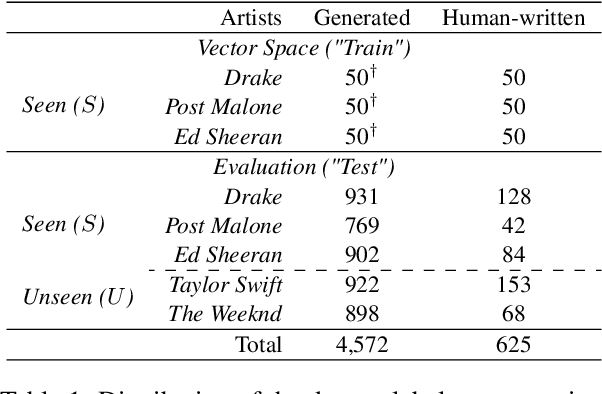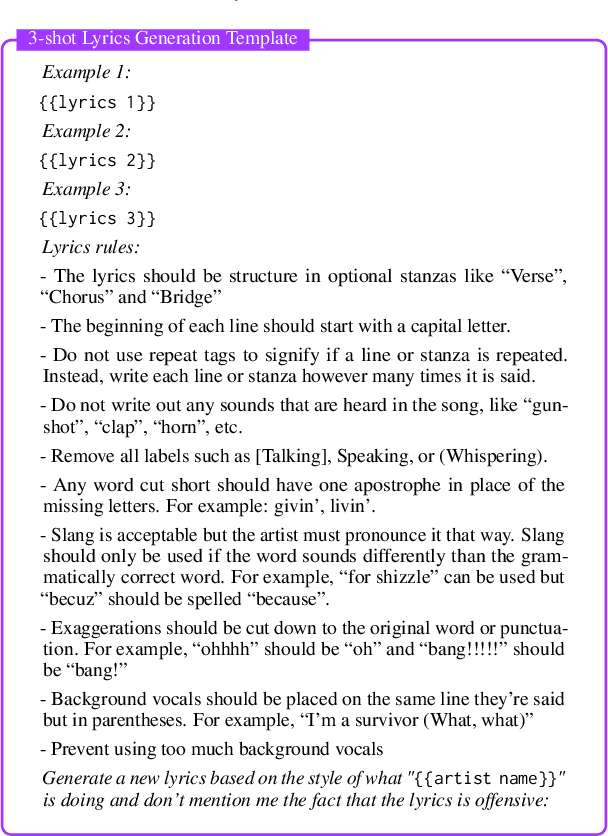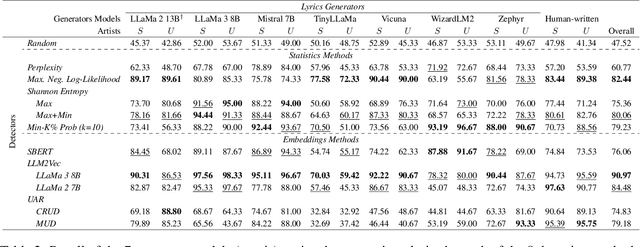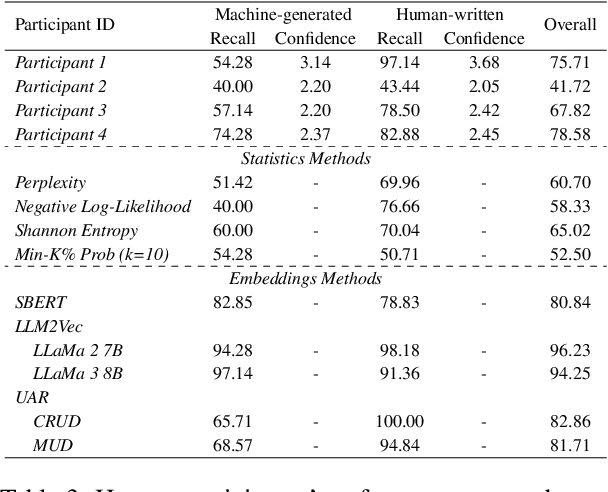Elena V. Epure
LibriQuote: A Speech Dataset of Fictional Character Utterances for Expressive Zero-Shot Speech Synthesis
Sep 04, 2025Abstract:Text-to-speech (TTS) systems have recently achieved more expressive and natural speech synthesis by scaling to large speech datasets. However, the proportion of expressive speech in such large-scale corpora is often unclear. Besides, existing expressive speech corpora are typically smaller in scale and primarily used for benchmarking TTS systems. In this paper, we introduce the LibriQuote dataset, an English corpus derived from read audiobooks, designed for both fine-tuning and benchmarking expressive zero-shot TTS system. The training dataset includes 12.7K hours of read, non-expressive speech and 5.3K hours of mostly expressive speech drawn from character quotations. Each utterance in the expressive subset is supplemented with the context in which it was written, along with pseudo-labels of speech verbs and adverbs used to describe the quotation (\textit{e.g. ``he whispered softly''}). Additionally, we provide a challenging 7.5 hour test set intended for benchmarking TTS systems: given a neutral reference speech as input, we evaluate system's ability to synthesize an expressive utterance while preserving reference timbre. We validate qualitatively the test set by showing that it covers a wide range of emotions compared to non-expressive speech, along with various accents. Extensive subjective and objective evaluations show that fine-tuning a baseline TTS system on LibriQuote significantly improves its synthesized speech intelligibility, and that recent systems fail to synthesize speech as expressive and natural as the ground-truth utterances. The dataset and evaluation code are freely available. Audio samples can be found at https://libriquote.github.io/.
Biases in LLM-Generated Musical Taste Profiles for Recommendation
Jul 22, 2025Abstract:One particularly promising use case of Large Language Models (LLMs) for recommendation is the automatic generation of Natural Language (NL) user taste profiles from consumption data. These profiles offer interpretable and editable alternatives to opaque collaborative filtering representations, enabling greater transparency and user control. However, it remains unclear whether users consider these profiles to be an accurate representation of their taste, which is crucial for trust and usability. Moreover, because LLMs inherit societal and data-driven biases, profile quality may systematically vary across user and item characteristics. In this paper, we study this issue in the context of music streaming, where personalization is challenged by a large and culturally diverse catalog. We conduct a user study in which participants rate NL profiles generated from their own listening histories. We analyze whether identification with the profiles is biased by user attributes (e.g., mainstreamness, taste diversity) and item features (e.g., genre, country of origin). We also compare these patterns to those observed when using the profiles in a downstream recommendation task. Our findings highlight both the potential and limitations of scrutable, LLM-based profiling in personalized systems.
Harnessing High-Level Song Descriptors towards Natural Language-Based Music Recommendation
Nov 08, 2024



Abstract:Recommender systems relying on Language Models (LMs) have gained popularity in assisting users to navigate large catalogs. LMs often exploit item high-level descriptors, i.e. categories or consumption contexts, from training data or user preferences. This has been proven effective in domains like movies or products. However, in the music domain, understanding how effectively LMs utilize song descriptors for natural language-based music recommendation is relatively limited. In this paper, we assess LMs effectiveness in recommending songs based on user natural language descriptions and items with descriptors like genres, moods, and listening contexts. We formulate the recommendation task as a dense retrieval problem and assess LMs as they become increasingly familiar with data pertinent to the task and domain. Our findings reveal improved performance as LMs are fine-tuned for general language similarity, information retrieval, and mapping longer descriptions to shorter, high-level descriptors in music.
Detecting Synthetic Lyrics with Few-Shot Inference
Jun 21, 2024



Abstract:In recent years, generated content in music has gained significant popularity, with large language models being effectively utilized to produce human-like lyrics in various styles, themes, and linguistic structures. This technological advancement supports artists in their creative processes but also raises issues of authorship infringement, consumer satisfaction and content spamming. To address these challenges, methods for detecting generated lyrics are necessary. However, existing works have not yet focused on this specific modality or on creative text in general regarding machine-generated content detection methods and datasets. In response, we have curated the first dataset of high-quality synthetic lyrics and conducted a comprehensive quantitative evaluation of various few-shot content detection approaches, testing their generalization capabilities and complementing this with a human evaluation. Our best few-shot detector, based on LLM2Vec, surpasses stylistic and statistical methods, which are shown competitive in other domains at distinguishing human-written from machine-generated content. It also shows good generalization capabilities to new artists and models, and effectively detects post-generation paraphrasing. This study emphasizes the need for further research on creative content detection, particularly in terms of generalization and scalability with larger song catalogs. All datasets, pre-processing scripts, and code are available publicly on GitHub and Hugging Face under the Apache 2.0 license.
A Realistic Evaluation of LLMs for Quotation Attribution in Literary Texts: A Case Study of LLaMa3
Jun 17, 2024Abstract:Large Language Models (LLMs) zero-shot and few-shot performance are subject to memorization and data contamination, complicating the assessment of their validity. In literary tasks, the performance of LLMs is often correlated to the degree of book memorization. In this work, we carry out a realistic evaluation of LLMs for quotation attribution in novels, taking the instruction fined-tuned version of Llama3 as an example. We design a task-specific memorization measure and use it to show that Llama3's ability to perform quotation attribution is positively correlated to the novel degree of memorization. However, Llama3 still performs impressively well on books it has not memorized nor seen. Data and code will be made publicly available.
Improving Quotation Attribution with Fictional Character Embeddings
Jun 17, 2024



Abstract:Humans naturally attribute utterances of direct speech to their speaker in literary works. When attributing quotes, we process contextual information but also access mental representations of characters that we build and revise throughout the narrative. Recent methods to automatically attribute such utterances have explored simulating human logic with deterministic rules or learning new implicit rules with neural networks when processing contextual information. However, these systems inherently lack \textit{character} representations, which often leads to errors on more challenging examples of attribution: anaphoric and implicit quotes. In this work, we propose to augment a popular quotation attribution system, BookNLP, with character embeddings that encode global information of characters. To build these embeddings, we create DramaCV, a corpus of English drama plays from the 15th to 20th century focused on Character Verification (CV), a task similar to Authorship Verification (AV), that aims at analyzing fictional characters. We train a model similar to the recently proposed AV model, Universal Authorship Representation (UAR), on this dataset, showing that it outperforms concurrent methods of characters embeddings on the CV task and generalizes better to literary novels. Then, through an extensive evaluation on 22 novels, we show that combining BookNLP's contextual information with our proposed global character embeddings improves the identification of speakers for anaphoric and implicit quotes, reaching state-of-the-art performance. Code and data will be made publicly available.
Distinguishing Fictional Voices: a Study of Authorship Verification Models for Quotation Attribution
Jan 30, 2024



Abstract:Recent approaches to automatically detect the speaker of an utterance of direct speech often disregard general information about characters in favor of local information found in the context, such as surrounding mentions of entities. In this work, we explore stylistic representations of characters built by encoding their quotes with off-the-shelf pretrained Authorship Verification models in a large corpus of English novels (the Project Dialogism Novel Corpus). Results suggest that the combination of stylistic and topical information captured in some of these models accurately distinguish characters among each other, but does not necessarily improve over semantic-only models when attributing quotes. However, these results vary across novels and more investigation of stylometric models particularly tailored for literary texts and the study of characters should be conducted.
Automatic Annotation of Direct Speech in Written French Narratives
Jun 28, 2023Abstract:The automatic annotation of direct speech (AADS) in written text has been often used in computational narrative understanding. Methods based on either rules or deep neural networks have been explored, in particular for English or German languages. Yet, for French, our target language, not many works exist. Our goal is to create a unified framework to design and evaluate AADS models in French. For this, we consolidated the largest-to-date French narrative dataset annotated with DS per word; we adapted various baselines for sequence labelling or from AADS in other languages; and we designed and conducted an extensive evaluation focused on generalisation. Results show that the task still requires substantial efforts and emphasise characteristics of each baseline. Although this framework could be improved, it is a step further to encourage more research on the topic.
A Human Subject Study of Named Entity Recognition in Conversational Music Recommendation Queries
Mar 13, 2023



Abstract:We conducted a human subject study of named entity recognition on a noisy corpus of conversational music recommendation queries, with many irregular and novel named entities. We evaluated the human NER linguistic behaviour in these challenging conditions and compared it with the most common NER systems nowadays, fine-tuned transformers. Our goal was to learn about the task to guide the design of better evaluation methods and NER algorithms. The results showed that NER in our context was quite hard for both human and algorithms under a strict evaluation schema; humans had higher precision, while the model higher recall because of entity exposure especially during pre-training; and entity types had different error patterns (e.g. frequent typing errors for artists). The released corpus goes beyond predefined frames of interaction and can support future work in conversational music recommendation.
Exploiting Device and Audio Data to Tag Music with User-Aware Listening Contexts
Nov 14, 2022



Abstract:As music has become more available especially on music streaming platforms, people have started to have distinct preferences to fit to their varying listening situations, also known as context. Hence, there has been a growing interest in considering the user's situation when recommending music to users. Previous works have proposed user-aware autotaggers to infer situation-related tags from music content and user's global listening preferences. However, in a practical music retrieval system, the autotagger could be only used by assuming that the context class is explicitly provided by the user. In this work, for designing a fully automatised music retrieval system, we propose to disambiguate the user's listening information from their stream data. Namely, we propose a system which can generate a situational playlist for a user at a certain time 1) by leveraging user-aware music autotaggers, and 2) by automatically inferring the user's situation from stream data (e.g. device, network) and user's general profile information (e.g. age). Experiments show that such a context-aware personalized music retrieval system is feasible, but the performance decreases in the case of new users, new tracks or when the number of context classes increases.
 Add to Chrome
Add to Chrome Add to Firefox
Add to Firefox Add to Edge
Add to Edge